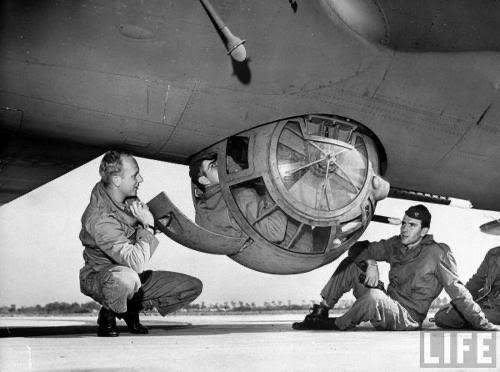Serving on a bomber in World War Two was almost a guaranteed death sentence.
Depending on the unit and time of the war, US bomber crews could experience anywhere from 50% to just over 70% of their personnel becoming killed, missing, or taken prisoner. With such appalling casualty counts, it is no wonder why those who stepped forward to volunteer did so to the shock and surprise of their compatriots.
But even with such a dangerous calling, some airmen in the community drew gasped shocks even from battle-hardened veterans at volunteering. These airmen were those that served as ball turret gunners.
During World War II, the United States developed and utilized a range of bomber aircraft to engage in strategic and tactical bombings against enemy targets.
Notable among these were the B-17 Flying Fortress and the B-24 Liberator, which were primarily used for long-range strategic bombing missions over Europe.
These bombers were characterized by their heavy defensive armaments, large bomb payloads, and multiple engines, which allowed them to operate over great distances and endure enemy fire.
Additionally, the B-29 Superfortress was introduced later in the war and played a critical role in the Pacific theater, notably dropping the atomic bombs on Hiroshima and Nagasaki.
The designs of these aircraft emphasized durability, payload capacity, and long-range capabilities, making them instrumental in U.S. aerial campaigns during the war.
The ball turret was a marvel of engineering, designed to be small to reduce drag, thus enhancing the aircraft’s performance. Despite being only four feet across, it was equipped with two Browning AN/M2 .50-caliber machine guns and a Sperry optical gunsight, making it a formidable defensive weapon. The turret could rotate 360 degrees, allowing the gunner to track targets regardless of their position. However, the compact design also meant that the gunner had to operate in a cramped space, making the job even more challenging.
The ball turret was developed by two separate companies, Emerson Electric and the Sperry Corporation. However, Sperry’s design was preferred and widely used. It was a hydraulically operated, altazimuth mount addition to two main aircraft: the Boeing B-17 Flying Fortress and Consolidated B-24 Liberator. The turret was also equipped by the PB4Y-1 Liberators operated by the US Navy, as well as the B-24’s successor, the Consolidated B-32 Dominator.
Training to be a ball turret gunner was intense. Prospective gunners underwent a six-week course of instruction in Texas, Arizona, or Florida. Before they could even touch a weapon, they were taught how to identify various aircraft with mock-ups and models. They also learned skills such as basic first aid, communications, and weapon safety fundamentals. Despite the risks and challenges associated with being a ball turret gunner, these brave men stepped forward to serve their country in one of the most dangerous roles during World War II.


